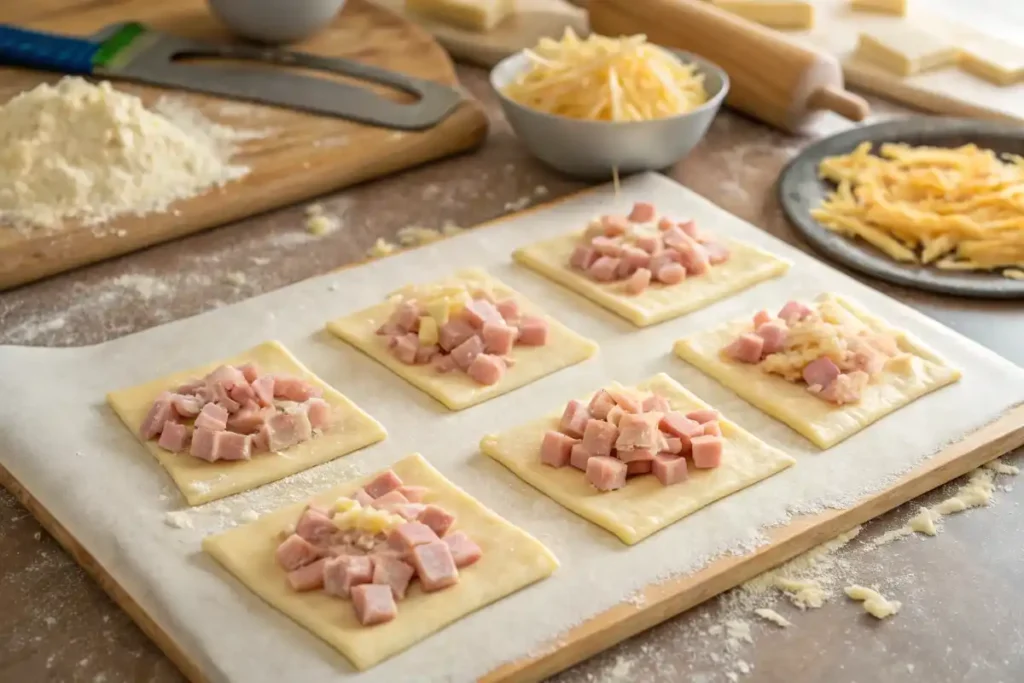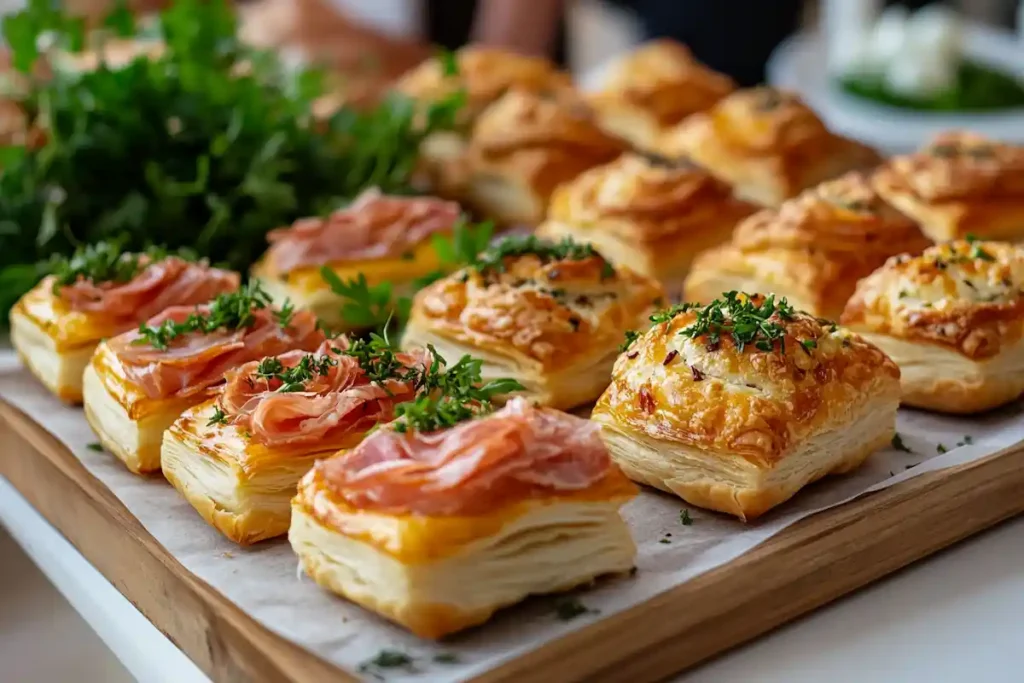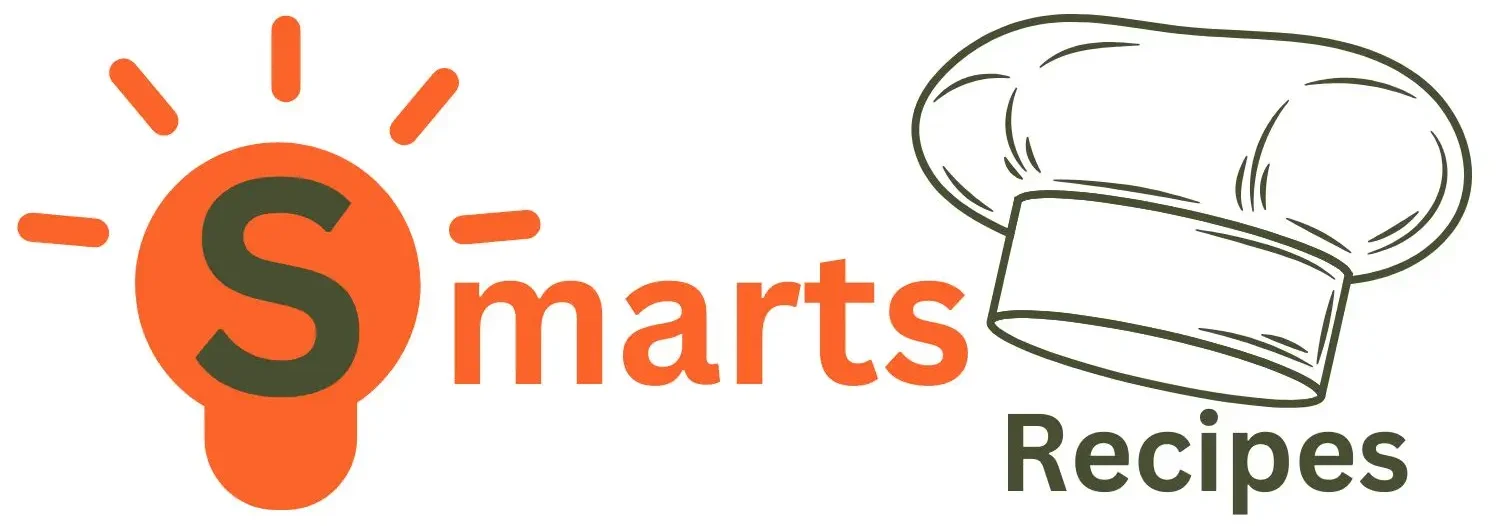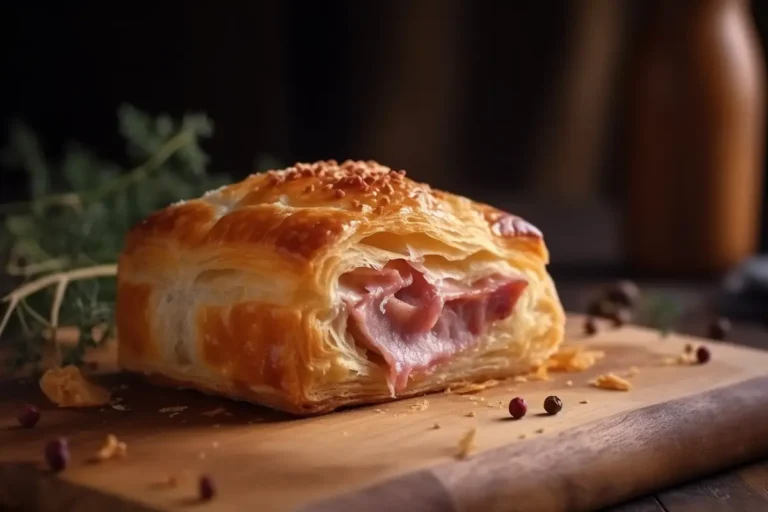Introduction
What is jambon made of? This question often pops up when curious food lovers encounter this savory delight for the first time. If you live in the United States and have recently come across jambon in a bakery or on a food blog, you might wonder about its components, origins, and why it has become so popular. In this article, we will dive deep into everything you need to know about jambon, from its traditional ingredients to step-by-step instructions and creative tips. Whether you are looking to make it at home or simply want to learn more about this tempting pastry, our guide provides all the details you need.
Jambon, at its core, is a simple and satisfying pastry commonly found in Irish bakeries and French-inspired cafés. While the word “jambon” is the French term for “ham,” the pastry itself has evolved into a beloved grab-and-go breakfast or lunch item throughout many parts of Europe, particularly Ireland. Over time, innovative cooks have tweaked the filling, crust, and even added cheese to create different spins on this classic. By the end of this article, you will not only know what jambon is made of, but you will also learn how to make it yourself, experiment with variations, and troubleshoot any pitfalls that might arise.
If you have ever stopped mid-bite and questioned, What is jambon made of?, rest assured that you are not alone. Let’s explore where jambon comes from, why it has endured as a bakery favorite, and how you can replicate this flaky pastry at home.
1. A Brief History and Overview of Jambon
The word “jambon” is French for “ham,” yet its pastry form is popularly identified with Irish deli counters and bakeries. In Ireland, jambons typically appear as small squares or rectangles of puff pastry filled with diced ham and cheese. French versions of jambon pastries often feature ham and sometimes béchamel sauce wrapped in croissant dough or puff pastry, known as “jambon-beurre” (ham and butter) or “jambon-fromage” (ham and cheese). While the French approach emphasizes delicate textures and high-quality, often artisan, ingredients, the Irish approach is a bit heartier.
If you find yourself asking again, “What is jambon made of?”, the simplest answer is ham, cheese, and puff pastry. But the deeper story of how jambon evolved into distinct Irish and French versions reveals how culinary traditions adapt to regional tastes.
The Irish Bakery Staple
In Ireland, you will find jambons in local bakeries, convenience stores, and supermarkets. Often sold as a quick breakfast or lunch item, these pastries are known for their crispy exterior and melty cheese filling. Irish jambons became mainstream in the 1990s and continue to evolve with modern flavors like herb-infused cheese, mustard sauce, or even vegetarian alternatives using plant-based “ham.”
French Jambon Influence
French-style jambon typically references ham slices used in various dishes—think of a classic “jambon-fromage” baguette (a simple ham and cheese sandwich). When it comes to pastries, the French variation often uses high-quality ham, such as jambon de Paris, with a touch of creamy sauce. This approach is more about highlighting the ham rather than the cheese. Consequently, French bakeries might serve a lighter, flakier pastry compared to the often more substantial Irish jambon.
Modern Popularity
As global cuisine continues to blend, Americans increasingly discover jambon through social media or travel. In U.S. bakeries, you might spot “ham and cheese croissants” or “ham and cheese turnovers,” which are essentially close relatives to Irish jambons. Some gourmet establishments even experiment with premium hams (like prosciutto or Serrano) for a fusion take on the dish. Whether you are a foodie or a casual diner, jambon has something to offer: a crisp pastry shell, savory ham filling, and delightful bursts of cheese. But at its core, what is jambon made of? It is the universal combination of tender ham and melted cheese wrapped in flaky pastry.
2. Key Ingredients of Jambon
One of the most common questions is: What is jambon made of? Traditionally, jambons rely on a few essential ingredients. Understanding the components helps you appreciate the flavor and also opens the door to creative variations.
Puff Pastry
- Typically store-bought puff pastry is used for convenience.
- Homemade puff pastry offers a flakier texture, but it is time-consuming.
Ham
- Diced or cubed ham is standard in Irish jambons.
- High-quality ham can elevate the flavor significantly (e.g., smoked ham, honey-glazed ham, or even leftover holiday ham).
Cheese
- Cheddar is the most common cheese in Irish versions.
- Some variations use Gruyère, mozzarella, or a mix of cheeses for depth and creaminess.
Egg Wash
- Usually made from a beaten egg with a tablespoon of water or milk.
- Helps give the pastry a golden-brown sheen when baked.
Optional Add-Ons
- Sauces: Béchamel, Dijon mustard, or garlic aioli can enhance flavor.
- Herbs & Spices: Thyme, chives, black pepper, or smoked paprika.
Nutritional Overview of the Core Ingredients
- Puff Pastry: High in carbohydrates and fats, providing the crispness we love.
- Ham: Good source of protein but can be high in sodium.
- Cheese: Rich in calcium and fats; cheddar brings a savory tang.
- Egg Wash: Adds minimal calories but helps with texture and appearance.
When assembled in moderation, jambon can be a satisfying treat without going overboard. Yet people still ask, “What is jambon made of?” because each component plays a crucial role in delivering flavor and texture. Using leaner ham or reduced-fat cheese can slightly reduce the overall calorie content, making it easier to enjoy this pastry more often.
For those wondering what is jambon made of in terms of nutrition, here’s a breakdown of its key macronutrients. The following values are approximate and can vary depending on the specific brand of puff pastry, cheese, and ham used.
| Nutrient | Amount (Per 100g) | % Daily Value (DV) |
|---|---|---|
| Calories | 320 kcal | 16% |
| Total Fat | 20g | 31% |
| Saturated Fat | 10g | 50% |
| Cholesterol | 45mg | 15% |
| Sodium | 600mg | 25% |
| Total Carbohydrates | 25g | 8% |
| Dietary Fiber | 1g | 4% |
| Sugars | 1g | – |
| Protein | 12g | 24% |
| Calcium | 150mg | 15% |
| Iron | 1.2mg | 6% |
By understanding what is jambon made of, including its nutritional content, you can make informed choices about how to enjoy this delicious pastry within a balanced diet.
3. Step-by-Step Instructions for Making Classic Jambon

If you want to replicate an authentic Irish bakery-style jambon at home, follow the detailed steps below. This recipe yields about 8–10 jambon pastries, depending on how you cut your puff pastry sheets. After all, what is jambon made of? The best answer is a well-executed blend of ham, cheese, and flaky pastry.
Ingredients Checklist
- 1 lb (450g) store-bought puff pastry (thawed if frozen)
- 1 cup diced ham (roughly 6–8 oz)
- 1 cup shredded cheddar cheese (mild or sharp)
- 1 egg, beaten (for egg wash)
- Pinch of black pepper (optional)
- Pinch of dried thyme (optional)
- Flour, for dusting the work surface
Equipment Needed
- Rolling pin
- Pastry brush
- Baking sheet
- Parchment paper or silicone baking mat
- Sharp knife or pizza cutter
Instructions
- Preheat Your Oven
- Set your oven to 400°F (200°C).
- Line a baking sheet with parchment paper or a silicone mat to prevent sticking.
- Prepare the Puff Pastry
- Dust your work surface lightly with flour.
- Roll out the puff pastry sheet into a rectangle, about ⅛ inch thick.
- If your puff pastry comes pre-rolled, simply lay it out flat.
- Cut into Squares
- Using a sharp knife or pizza cutter, divide the pastry into squares about 4×4 inches.
- The exact size can vary based on how large you want your jambons.
- Add the Filling
- Place a spoonful of diced ham in the center of each square.
- Top with a sprinkle of cheddar cheese.
- Season with black pepper or thyme if desired.
- Fold or Pinch the Squares
- Fold each corner toward the center, overlapping slightly so the filling remains visible.
- You can also create a pocket shape by bringing opposite corners together.
- Apply Egg Wash
- Whisk the egg in a small bowl.
- Lightly brush the tops of the pastry with the beaten egg.
- This step ensures a golden-brown finish.
- Bake
- Transfer the pastries to your lined baking sheet.
- Place them in the preheated oven and bake for about 15–18 minutes.
- Watch for a puffy, golden crust, indicating they are ready.
- Cool and Serve
- Remove the jambons from the oven and let them rest for 2–3 minutes.
- Serve warm to enjoy the melted cheese and crisp pastry.
Following these steps will yield a classic, flaky jambon that mirrors the Irish bakery experience. Whenever you wonder, “What is jambon made of?”, this recipe provides a clear answer: a perfect harmony of puff pastry, ham, and cheese.
4. Tips & Tricks for Perfect Jambon
Crafting the perfect jambon involves more than just assembling ingredients. Below are some tips that can elevate your jambons from ordinary to extraordinary, giving you deeper insight into what is jambon made of? and how to get the most out of each component.
- Use Cold Pastry
- Keep your puff pastry as cold as possible to ensure it puffs up nicely in the oven.
- If it becomes too warm, chill it for 10 minutes before baking.
- Avoid Overstuffing
- Resist the temptation to add too much ham or cheese.
- Too much filling can lead to the pastry not sealing properly or leaking in the oven.
- Experiment with Cheeses
- Cheddar is classic, but feel free to try Gruyère for a nutty taste or mozzarella for extra stretch.
- A blend of cheeses can add complexity.
- Add a Sauce
- A small spoonful of béchamel or Dijon mustard can add creaminess and tang.
- Ensure the sauce is thick to avoid making the pastry soggy.
- Season Wisely
- Ham often brings enough salt, so go easy on added salt.
- Freshly cracked black pepper or mild herbs like chives can boost flavor without overpowering.
- Monitor Baking Time
- Puff pastry can go from perfect to burnt quickly.
- Check on your jambons around the 12-minute mark to prevent over-browning.
- Proper Storage
- Store leftovers in an airtight container in the fridge for up to 2 days.
- Reheat in a toaster oven or conventional oven to maintain crispness.
By following these guidelines, you will not just know what is jambon made of, but also how each technique—like keeping puff pastry cold or using the right cheese—elevates the overall result.
5. Creative Variations of Jambon
For those who love to experiment, jambons provide a versatile canvas. You can swap out ingredients, add new elements, or even push the boundaries beyond ham and cheese. In your quest to discover what is jambon made of?, you may find that the pastry is only the beginning of its culinary possibilities.
Gourmet Flair
- Prosciutto & Gruyère Jambon
- Use thinly sliced prosciutto and top with shredded Gruyère.
- Add a light brush of pesto for an herbal touch.
- Goat Cheese & Caramelized Onion
- Replace ham with caramelized onions for a vegetarian spin.
- Crumble goat cheese on top for a tangy kick.
Health-Conscious Versions
- Whole Wheat Puff Pastry
- Some specialty stores offer whole wheat puff pastry.
- While not as light, it adds fiber and a slightly nutty flavor.
- Low-Sodium Ham and Reduced-Fat Cheese
- Keep an eye on sodium levels by using low-salt ham.
- Reduced-fat cheddar or mozzarella can cut down on total fat without sacrificing too much flavor.
Breakfast Jambons
- Egg & Ham Jambon
- Crack a small egg into the pastry along with diced ham and cheese.
- Bake until the egg sets for a hearty breakfast option.
- Maple-Glazed Bacon Twist
- Swap the ham for crispy bacon glazed with maple syrup.
- Pair with a mild cheddar for a sweet-and-savory mix.
International Fusion
- Tex-Mex Jambon
- Use spicy chorizo or taco-seasoned ground beef instead of ham.
- Top with pepper jack cheese and serve with salsa on the side.
- Italian-Inspired
- Fill with pepperoni or salami and shredded mozzarella.
- Serve with marinara sauce for dipping.
These variations highlight that what is jambon made of? can adapt to different cultural tastes, making the pastry a crowd-pleaser that transcends borders.

6. Frequently Asked Questions About What is Jambon Made of?
Below are the top four frequently asked questions about jambon, curated from People Also Ask (PAA) and other popular search queries. We address them in detail to clear up any confusion, especially for those still wondering, “What is jambon made of?”
1. What kind of ham is jambon?
Traditionally, jambon features diced or thinly sliced ham. In Irish bakeries, the ham is usually cubed or shredded. For a French jambon-fromage sandwich, it might be a high-quality ham like jambon de Paris, which is lightly seasoned and moist. However, any cooked ham—such as honey-glazed or smoked ham—can work well. The choice often depends on personal taste and availability. Opting for premium ham can add a gourmet twist to the pastry, giving you an even richer answer to What is jambon made of?
2. Is jambon good for you?
Jambon can be part of a balanced diet if enjoyed in moderation. Puff pastry contains butter and refined flour, which makes it relatively high in calories and fats. Ham is a source of protein but can be high in sodium. Cheese adds calcium but also brings additional fats. To make jambon a healthier option, consider:
- Using lean or low-sodium ham.
- Selecting reduced-fat cheese.
- Pairing the pastry with a side salad or fresh fruit.
Ultimately, jambon is best enjoyed as an occasional treat rather than an everyday meal. Still, if someone asks you, What is jambon made of?, you can mention its basic components while noting that mindful ingredient choices can make it more nutritious.
3. What is the difference between Jamon and jambon?
While “jambon” (French) and “jamon” (Spanish) both translate to “ham,” they refer to different products. “Jamon” in Spanish cuisine typically means a cured ham (such as Jamón Serrano or Jamón Ibérico). These are aged, salted hams that boast a rich, distinctive flavor profile and are often sliced paper-thin. On the other hand, “jambon” in French simply refers to ham, which can be fresh, cured, or lightly cooked, depending on the preparation. When you see “jambon” on an Irish bakery menu, it’s referencing a ham-and-cheese pastry. So if you’re still curious what is jambon made of, note that it usually involves cooked ham, whereas Spanish “jamon” is a cured specialty.
4. What cheese is in jambon?
Cheddar is the classic choice in Irish-style jambons due to its sharp, melt-friendly consistency. However, the French might opt for Gruyère or Emmental. Cheeses like mozzarella, pepper jack, or a blend of multiple cheeses can also be used to customize flavor and texture. Ultimately, the choice of cheese comes down to personal preference. If you want a stronger flavor, go with a sharp cheddar or Gruyère. For a milder taste, mozzarella or a mild cheddar works well. In the grand scheme of what is jambon made of, cheese is the element that adds creaminess and depth to each bite.
7. Additional Expert Insights and Cooking Hacks
While jambons might seem straightforward, a few extra insights can help you elevate your culinary game. For those who keep asking, “What is jambon made of?”, here are some advanced tips that dig into how each element can be optimized.
- Chill the Filled Pastries
- After assembling but before baking, place your jambons in the fridge for 10–15 minutes.
- This step helps the puff pastry retain its shape and rise better.
- Use a Laminated Dough
- If you have extra time, consider making your own laminated dough.
- This technique creates distinct buttery layers that puff up beautifully.
- Cheese Placement
- Placing some cheese below and some cheese on top of the ham ensures a gooey center and a slight crusty top.
- Egg Wash Alternatives
- For a more vibrant golden color, whisk an egg yolk with a splash of cream.
- If you prefer a vegan wash, use plant-based milk mixed with a little oil.
- Freezing Tips
- Prepare extra jambons and freeze them unbaked on a tray.
- Once frozen, store them in a sealed container for up to 2 months.
- Bake from frozen by adding an extra 5 minutes to the baking time.
Understanding these details allows you to share more informed answers when friends ask, What is jambon made of? You can highlight how technique and ingredient handling significantly impact the final product.
8. Serving Suggestions and Pairings
A freshly baked jambon is delightful on its own, but pairing it with complementary sides and drinks can create a complete meal experience. If you truly want to experience what is jambon made of? in all its glory, consider these serving tips:
- Salads
- A simple green salad with a light vinaigrette balances the richness of the pastry.
- Adding some sliced fresh tomatoes or cucumbers provides a refreshing contrast.
- Soups
- A bowl of tomato soup or creamy potato soup goes nicely with the savory pastry.
- Try a lighter broth-based soup, such as vegetable or chicken noodle, to keep the meal balanced.
- Sauces and Dips
- Dijon mustard or a tangy aioli can enhance the flavor of the jambon.
- A spicy sauce, like sriracha mayo, can provide a pleasant kick.
- Beverage Pairings
- For breakfast, pair with a latte or a cup of tea.
- For a lunch or dinner vibe, consider a crisp white wine like Sauvignon Blanc or a light red wine like Pinot Noir.
- Sparkling water with lemon can also cut through the richness effectively.
9. Common Pitfalls and How to Avoid Them
Despite its simplicity, a jambon can go wrong if not executed carefully. Here are some common pitfalls and tips to ensure your pastries come out perfect each time. By understanding these challenges, you’ll have a fuller picture of what is jambon made of? and how each ingredient behaves under different conditions.
- Soggy Bottoms
- Overly moist ham or wet sauces can make the pastry soggy.
- Pat the ham dry with paper towels, and use thicker sauces.
- Burnt Pastry
- Puff pastry can quickly brown too much if your oven runs hot.
- Check the pastries around 12 minutes into baking. Lower the temperature slightly if necessary.
- Filling Leakage
- If the edges are not sealed or folded properly, cheese and ham can spill out.
- Use a bit of water or egg wash as “glue” to secure corners.
- Undercooked Centers
- Ensure the pastry is thin enough to cook evenly.
- If the outside is browning too fast, reduce the oven temperature and bake a bit longer.
Being aware of these pitfalls will help you troubleshoot if your first attempt isn’t picture-perfect. With practice, you will master the nuances of making the ideal jambon, and you will never again wonder, “What is jambon made of?” when it comes to technique and execution.
Conclusion
Jambon is a savory pastry that brilliantly combines puff pastry, ham, and cheese into a handheld bite of comfort. Understanding what is jambon made of goes beyond its core ingredients. It involves delving into its history—rooted in Irish bakeries yet influenced by French cuisine—and experimenting with variations to suit your personal tastes. Whether you stick to the classic Irish cheddar-filled rendition or branch out into gourmet territory, jambons offer a versatile canvas for culinary creativity.
By following our detailed step-by-step guide and incorporating the expert tips, you can create bakery-quality jambons right in your own kitchen. Remember to keep your pastry cold, avoid overstuffing, and choose a cheese that melts beautifully. Adding different sauces, herbs, or even alternative fillings can further expand your jambon repertoire. Ultimately, this pastry proves that simple ingredients—puff pastry, ham, and cheese—can transform into a memorable meal or snack when handled with the right techniques.
No matter how you enjoy them—hot from the oven for breakfast or paired with a fresh salad for lunch—jambons are sure to delight your taste buds. So, gather your ingredients, roll up your sleeves, and get ready to fill your home with the comforting aroma of freshly baked pastry. The next time someone asks, “What is jambon made of?” you’ll be well-prepared to answer with confidence and expertise.
Print
Classic Jambon Recipe
- Total Time: 25-30 minutes
- Yield: 4 servings 1x
Description
Jambon is a savory pastry that has become a staple in Irish bakeries and French-inspired cafés. The term “jambon” is French for “ham,” and the pastry typically consists of diced ham and cheese encased in flaky puff pastry. In Ireland, jambons are popular as a grab-and-go breakfast or lunch item, known for their crispy exterior and melty cheese filling. Over time, various adaptations have emerged, including versions with herb-infused cheese or mustard sauce.
Ingredients
- 1 sheet of puff pastry
- 1 cup diced cooked ham
- 1 cup shredded cheese (e.g., cheddar or Gruyère)
- 1 egg, beaten (for egg wash)
Instructions
- Preheat Oven: Preheat your oven to 400°F (200°C).
- Prepare Pastry: Roll out the puff pastry sheet on a lightly floured surface.
- Add Filling: Evenly distribute the diced ham and shredded cheese over the pastry.
- Fold and Seal: Fold the pastry over the filling to form a rectangle or square. Press the edges to seal.
- Apply Egg Wash: Brush the top with the beaten egg for a golden finish.
- Bake: Place on a baking sheet and bake for 15-20 minutes, or until golden brown.
- Serve: Allow to cool slightly before serving warm.
Notes
- Variations: Experiment with different cheeses or add a touch of mustard for extra flavor.
- Storage: Store any leftovers in an airtight container in the refrigerator for up to 2 days. Reheat in the oven to maintain crispiness.
- Prep Time: 10 minutes
- Cook Time: 15-20 minutes
- Category: Breakfast
- Method: Baking
- Cuisine: Irish
Nutrition
- Serving Size: 1 pastry
- Calories: 350
- Sugar: 1g
- Sodium: 800mg
- Fat: 22g
- Carbohydrates: 22g
- Fiber: 1g
- Protein: 15g
- Cholesterol: 70mg
Keywords: Jambon, ham and cheese pastry, Irish snack

